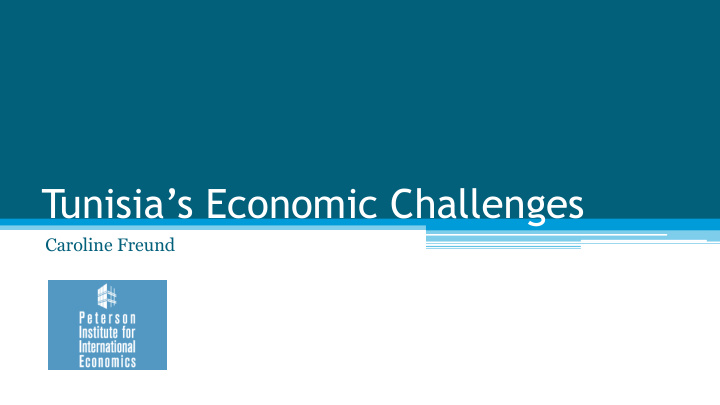



Tunisia’s Economic Challenges Caroline Freund
Tunisia Economic Challenges • Structural issues: ▫ Bloated civil service ▫ Energy subsidies ▫ Regulations and rent-seeking • Results: ▫ Insufficient growth ▫ Low labor force participation and high unemployment • Short-run challenges: ▫ Security ▫ Uncertainty and policy predictability • Results: ▫ Weak investment and low tourism ▫ Lower growth and higher unemployment ▫ Fiscal and current account deficits
Growth Then and Now Real GDP growth, Tunisia, 2000-2013 annual percent 6 4 2 0 -2 2000 2002 2004 2006 2008 2010 2012 2014 Note: 2013 represents the World Bank estimated growth Source: World Bank World Development Indicators
Labor Force Participation and Employment Labor Force Participation, Tunisia, 2012 Unemployment rate, Tunisia, 2000-2013 percent of population, ages 15 and older percent 80 30 60 25 40 20 15 20 10 0 Female Male Total 2000 2002 2004 2006 2008 2010 2012 2014 Unemployment, total (% of total labor force) Unemployment, male (% of male labor force) Unemployment, female (% of female labor force) Note: 2013 excludes Q4 Sources: World Bank World Development Indicators Institut National de la Statistique(INS), Enquête Nationale sur la Population et l'Emploi (Tunisia)
Subsidies and Government Jobs Number of Employees in the Public Sector (government and state owned enterprises) Tunisia, 2006-2012 thousands 720 710 700 690 680 2006 2008 2010 2012 2014 Source: Boughzala, 2013; Internatlional Labor Organization, 1996-2012
Corruption//State Capture • Transparency International Corruption Perceptions Index ▫ 2010 Tunisia ranked 59 (out of 178) jointly with Latvia and Slovakia, below Turkey and above Croatia. ▫ 2013 Tunisia ranked 71 (out of 175) jointly with Bulgaria and Senegal, above Greece below South Africa • Tunisia’s problem was rent-seeking not corruption ▫ Excesses of Ben Ali family inspire outrage ▫ Bouebdelli School closed because in competition with International School Carthage. ▫ McDonalds told they had the “wrong partner”
Ben-Ali’s Family Tree Zine El Abidine Ben Ali Leila Trabelsi (2 firms) Leila Trabelsi’s Siblings (73 firms) ZA Ben Ali 's Siblings (21 firms) • Belhassen Trabelsi & Zahra Jilani (38) Tijani Ben Ali & Paulette Ben Ali (4) • Med Adel Trabelsi & Souad Ben Jemiai (3) • • Naima Ben Ali (6) Med Mourad Trabelsi & Hela Belhadj (7) • • Hayet Ben Ali (6) Med Ennaceur Trabelsi & Nadia Mufti (6) • • Houria Ben Ali (1) • Moncef Trabelsi & Yamina Souiai (5) • Najet Ben Ali & Sadok Mhiri (3) • Jalila Trabelsi (4) • Faouzi Ben Ali (1) • Nefissa Trabelsi & Habib Ben Zakis (2) • Samira Trabelsi & Med Montassar Meherzi (7) Children with Naima Kefi Children with Leila Trabelsi and in laws (24 firms) and in laws (40 firms) • Ghazoua Ben Ali & Slim Zarrouk (6) • Nesrine Ben Ali & Sakhr El Materi (36) • Syrine Ben Ali & Marouane Mabrouk (8) • Halima Ben Ali & Mehdi Ben Gaied (4) • Dorsaf Ben Ali & Slim Chiboub (10) Trabelsi nieces and nephews Ben Ali nieces and nephews (59 firms) (36 firms)
State Capture in Tunisia • Firms connected to Ben Ali are relatively large and extremely profitable, especially in industries with entry regulation. 3% of output and 21% of profits! • Existing business regulations have been abused by the Ben Ali clan—allowing them to effectively exercise monopoly power. • The Ben Ali Business Group– was able to create rules, as needed, to protect their interests. • Policy role for outside experts in creating new business code.
Short Run--Transition is Tough • Political uncertainty • Policy uncertainty • Security concerns • Investors and tourists are waiting it out
Typical Growth Pattern in Transition
Growth Then and Now Real GDP growth, Tunisia, 2000-2013 annual percent 6 4 2 0 -2 2000 2002 2004 2006 2008 2010 2012 2014 Note: 2013 represents the World Bank estimated growth Source: World Bank World Development Indicators
Widening gaps • Current account deficit expanded to 8 percent of GDP in 2012 & 2013. • Fiscal deficit exceeded 6 percent in 2013. • Reserves cover just over 3 months of imports • Unsustainable for an extended period • Currency has weakened, but still room for movement. • Reform is urgent
Urgent Need for Reform • Short run ▫ Constitution is a major win for political stability ▫ IMF disbursement is a win for economic stability ▫ Refrain from wrong-direction reform ▫ Improve security ▫ Temporary job works programs ▫ Trade agreements and investment incentives • Structural ▫ Reduce energy subsidies ▫ Address civil service employment ▫ Reform business climate—revise investment code
Recommend
More recommend